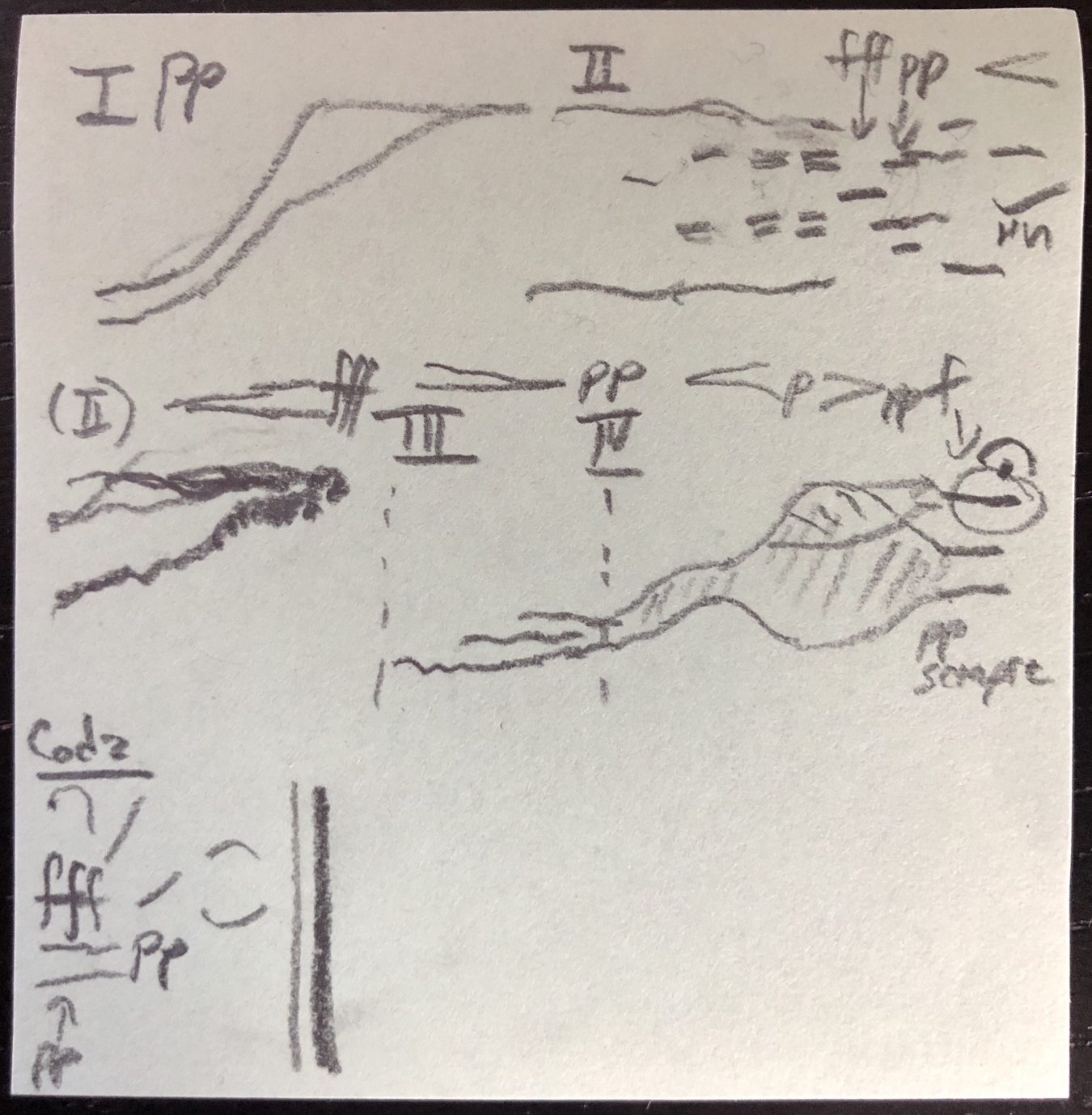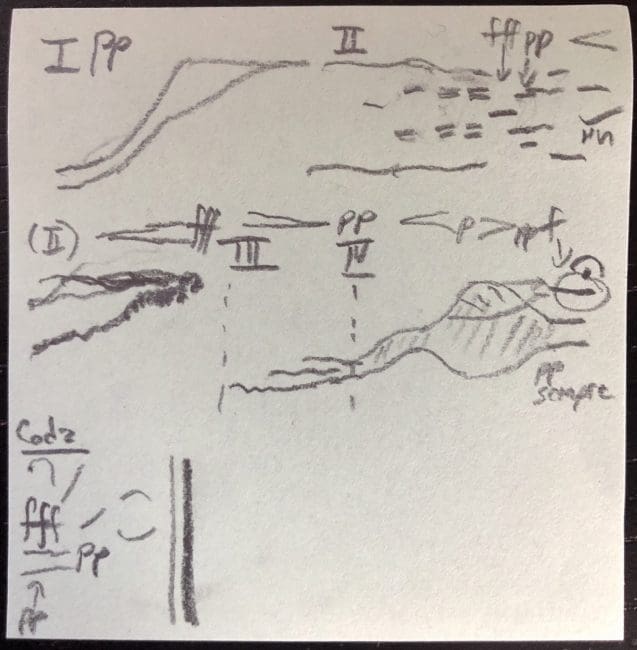This is not so much an analysis as it is the sketch or the start of one. Its goal is understand the compositional possibilities this movement suggests to me on a particular Tuesday afternoon.
While composing my latest piece for Hub New Music (with generous funding by the Barlow Endowment), I began to think of a recent experience I had, and this memory triggered a strong emotional and musical response. After composing out a sketch of this idea, I noticed that what I wrote and was imagining reminded me of the fourth movement of Ligeti’s Chamber Concerto. I don’t want blatantly to copy the movement, but I thought it prudent and useful to see what Ligeti does in it.
Here, for your listening pleasure, is that movement:
General Observations
First, some general observations:
- A very fast surface rhythm prevails throughout, but because it’s not perfectly stable (having both linear and contrapuntal variations), the music does not sound metronomic.
- Most of the piece is very quiet. Ligeti uses loud dynamics for formal purposes: to build to and from the climax* and to punctuate the coda. (On this idea of climax, see the heading entitled “Form” below.)
- Though it sounds really busy, much of the counterpoint in this piece actually consists only of 2-4 voices.
- Chromatic clusters feature prominently in the harmony—but when I say “harmony,” I don’t refer only to “vertical simultaneities.” For instance, I hear the opening clarinet duo more as an “arpeggiated” chromatic pentad (filling in and including all the chromatic notes of a P4) that gradually shifts upward from D3-G3 to E3-A3.
- No one will claim that this movement is easy to play. However, for three reasons, Ligeti’s voice-leading choices do make it more gracious than not to play:
- Though statistically the instruments are “arpeggiating” chromatic clusters of various sizes, Ligeti tends to avoid chromatic intervals unless he’s writing a fragment of the chromatic scale (3+ notes).’
- In turn, much of this “arpeggiation” takes place within the span of a fifth or even smaller. Further, within this span, two-thirds of the voice-leading consists of stepwise motion. The remaining voice-leading consists mostly of thirds, with only the occasional fourth or fifth. In other words, though these lines are fast, they require little physical motion.
- In situations when the arpeggiation spans wider than a fifth, Ligeti writes idiomatically for the instruments. For instance, the string writing in bar 43 ff. is accomplished by simple string crossing (of adjacent strings); fingering the exact pitches is otherwise just as economical as if Ligeti had written it all within the span of a fourth.
- Ligeti uses chromatic clusters prominently but not exclusively. For instance, near the end of the piece, the chromatic lines begin to be voice-led (roughly) by perfect fifths (see note in bar 49). Likewise, the run in bar 7 starts as a chromatic cluster but widens into a Major 7th chord, and then a polytonal one in bar 8. The tonal reference of these sonorities is very weak, but the difference in harmonic content and voicing is clearly audible.
- This is a good place to note that the distinction between “Pitch set” and “Pitch-class set” is very useful in this piece. “Pitch-class set” describes “all the pitches sounding irrespective of their octave.” In contrast, “pitch set” refers to the actual registers in which those pitches reside. The collection of pitches in bar 8 may all belong to the chromatic hexatonic pitch-class set (m2-m3-m2-m3-m2), but the pitch set of this collection is audibly arranged as a polychord (B-flat minor over D major). Now, in common-practice music, triads can be voiced, inverted, and doubled in myriad ways but still retain a clear relationship to their root-position chord. Not so in chromatic music: very few (if any) people will hear the Dmaj-Bbmin polychord as a revoicing of chromatic hexatonic collection.
Form
I hear the piece in four major sections. The closure of three of these (1st, 2nd, 4th) is defined a harmonic coalescence around a dyad or triad. The third major section comes to repose by reaching the registral extreme of the piano.
- I
- bar 1: two clarinets fill in a D3-G3 that gradually shifts up to E3-A3 and then thins out . . .
- bar 5: coalescing on the E3-A3 dyad and ending in an upward run (bar 7) to
- bar 8: coalesce on D major/B-flat minor polychord spanning D5-F6. The registral band narrows to . . .
- bar 14: the E6-F6 trill, which voice-leads up to . . .
- II
- bar 15: F#, inaugurating a unison (+ 4 octaves) line between the piccolo and bass clarinet. This line is re-orchestrated/doubled in various chromatic pitch-class sets. It’s taken over by the piano as P5 (+ 4 octaves) at the end of bar 23.
- bar 24: The horn (which entered on a sustain note in bar 22) leads off a melodic line (doubled by strings then winds). The surface rhythm of this line gradually accelerates as its register also increases. Meanwhile the piano (sempre fortissimo) also increases in density and register until . . .
- III
- bar 31: It is cut off by the double bass solo (with a subtle trombone sustain) that chromatically spans E1-A1. This band remains ≈P4/A4, changes color slightly (other instruments with these same pitches and rhythms that align on but not within notated beats) slowly transposes up . . .
- bar 40: . . . to coalesce on C#2-G2 dyad with bass clarinet and cello
- IV
- bar 42: The violins, viola, and cello begin to arpeggiate chromatic lines roughly a fifth apart (and span roughly 2.5 octaves) that are moving upward at an unstable, unequal rate. In bar 45, the winds enter, sustaining pitches from the strings. In bar 46, the strings exchange similar for contrary motion until . . .
- bar 49: the strings ultimately (albeit for only half a bar) arpeggiate a 6-octave span of fifths from Bb1 to F#6. They then move by contrary motion inward. Meanwhile, high winds resume their chattering over a span of about an octave that rises over two bars from the bass register into the soprano/alto one, then only above the treble staff (roughly mid bar 51).
- bar 52: Meanwhile, the strings’ contrary motion leads to the cello and bass sustaining A3 and the violins and viola trilling A4/Bb4.
- bar 53: The high wind chatter narrows around and then leaves only the oboe’s loooong forte D#6 (against the strings’ A/Bb).
- Coda: Ligeti finishes by arpeggiating 3-4 chromatic clusters (depending on how you want to count them) in the winds and keyboards: two loud gestures followed by a few quiet ones.
To sum up, here is my simplified, not-at-all-to-scale, graphical-sketch-on-a-post-it-note (the relative height of the lines represents pitch):

I asterisked the word climax when I mentioned it in the previous heading. I’m not definitively prepared to say that the loud part at the end of section II is the movement’s climax. It is definitely “the loudest part in the middle of the piece,” so in that sense, it is climactic. However, section IV leads also somewhere just as rich (the widest and fullest texture of the whole piece) and noteworthy (the loooong, loud oboe note).
Lacking the time to examine the particulars closely enough to build a solid case one way or the other, I will point out that the build to fortissimo in section II does create a reference point to which the end of section IV/start of the coda responds. In other words, just as the formal parallelisms between the four sections help demarcate them as sections, the parallels between the ending of sections II and IV are formally significant. That is, what happens at the end of section II helps the end of the piece sound like the end of the piece.
Takeaways I Will Use Immediately
Though some of these general and formal observations will be useful for me in writing my piece for Hub New Music, my most immediate takeaways have to do with deliberate use of register and density. Here are some compositional exercises and experiments I’m going to try as a result of studying this piece:
- Identify narrow registral bands (less than, say, 1.5 octaves). Sketch some ideas specific to that register and its associated tone colors. (Karalyn Schubring has a cool piano piece that does this.)
- Imagine these passages:
- using different collections
- in different registers
- at different dynamics
- with different doublings/parallel motion
- What different gestures can I create, more than static bands?
- Upward/downward runs?
- Expanding and contracting collections?
- Different “interference patterns” (polyrhythms or distinct rhythmic layers)?
- These, in combination with increasing/decreasing voices? Changing doublings?
- How long must one of these gestures be so that it doesn’t sound like a melody but as something larger? (I imagine the answer exists in relation to (1) the size of the collection I’m trying to express, (2) the number of voices expressing that collection, and (3) the rate at which the whole collection can be presented.)
- Of what different idioms can I take advantage for the various instruments that will make my music easier for them to play?
Developing these initial experiments and having some clear reference points for them was my purpose for analyzing that movement by Ligeti. By the time you read this blog post, I will have already conducted many of these experiments.
Sign up to stay in the loop about my music—and ideas for your own composing!


